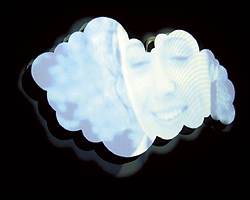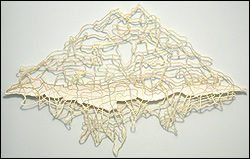At first glance, “The Décor Project,” by Vancouver-based artists Hadley & Maxwell, seems as interesting as staring at the bottom of your closet. On the walls of Howard House, five series of large-scale photographs document nondescript interior spaces. Some are cluttered, some neat; some are artificially lit, some bathed in natural light. All in all, it isn’t much to look at.
But as in most conceptual art, things are not as simple as they seem.
Hadley Howes and Maxwell Stephens have been collaborating for seven years on a variety of postmodern conceptual projects. For “The Décor Project,” they asked several curators, gallery owners, and art collectors for permission to enter their homes. The artists rearranged the interiors and took photographs, then put everything back in its place. The resulting project crosses the boundary between public and private space, a theme that has special resonance in the tight-knit gallery world. For every artist who’s knocked at the door of the art establishment, it’s a tantalizing turning of the tables—a chance to bring the messy act of creation into the private world of the cultural gatekeepers. And then display it for all the world to see.
For the curators, it becomes a supreme game of trust. It takes quite a bit of courage, after all, to give artists free rein in your home. Before entering, Hadley & Maxwell presented their subjects with a questionnaire. At the show, make sure to browse the binder containing these questions, which set the project in its proper context. Some of the questions are serious and revealing (“What three artworks would you most like to own? What’s your most prized possession?”); others are flippant (“Do you own any IKEA furniture?”). Here’s my favorite: “Frank Gehry is: a) a pervert; b) romantic; c) misguided and confused; d) a genius; e) other (please specify).”
One of those asked to participate in the project was the Frye Art Museum’s new curator, Robin Held. “There were some very provocative questions,” Held told me. “But, having seen their other works, I trusted them.”
The artists reworked Held’s apartment over several days. The photographs of it are subtle, almost coy. In the most compelling of the three, The Absent One, Hadley & Maxwell allude to Held’s stated fondness for the conceptual artist George Brecht by propping a bed on a chair (Brecht was a Fluxus artist whose works included arrangements of furniture). The focus of the photograph is on the small divot left in the carpet by the suspended bed—a sly study of absence. It also refers to Held’s slightly mysterious answer to a question about her favorite object in her home: “the space under my bed.”
In each photograph, the subject’s answers provide a rough framework for the reordering of space. It’s worth noting that Hadley & Maxwell rely on established photographers—in this case, Sven Boecker —to record their work. Conceptual art has always had a problematic relationship with photography; by using another person to document the project, the artists can focus on the act of transformation. Each photo, upon close inspection, reveals numerous layers of meaning.
In one image, titled Morisot, the artists attempt to re-create Manet’s portrait of Berthe Morisot in the home of a curator with an expressed fondness for the painting. Once again, it seems there isn’t much to look at: an interior with the usual furnishings and a floodlight. But hidden in the reflections—on a mirror, on the room’s metal surfaces—other images are visible, including a woman holding a fan across her face in the manner of Manet’s portrait. It’s such a rewarding tableau—about disguise and, ultimately, about revelation.
The most rewarding set of images, however, is White on White, a sequence of 17 photos shot once an hour throughout a single day in the home of Winnipeg curator Risa Horowitz. Judging from her questionnaire, Horowitz is a very private person, and she expressed serious reservations about two artists invading her space. In deference to her misgivings, the artists chose to shoot just one corner of the kitchen. In each of these photos, the subtle changes of light throughout the day are lovely, and the painting of date and time on the wall is reminiscent of one of Horowitz’s favorite artists, On Kawara. Hadley & Maxwell took extra precautions to shield Horowitz’s space from public view: Surfaces and objects throughout the room (including furniture, a radiator, a pepper mill, and a bowl of fruit) have been meticulously covered in white foam core. The resulting paradox is fascinating: a private space made public—but as a space in which every object is shielded from view by a delicate armor of white.
Several things about “The Décor Project” will forever remain mysterious. One photo taken in Held’s apartment is titled Decoy. When the artists arrived, Held told me, they brought boxes full of duck decoys. When they left, one decoy still was stashed beneath her bed. She called them about it, but the artists assured her, “They’re migratory animals. They’ll move on.” None of the ducks is in any of the photos.
“The Décor Project” runs through Feb. 3 at Howard House, 604 Second Ave., 206- 256-6399; 10:30 a.m.–5 p.m. Tues.–Sat. and by appointment.







